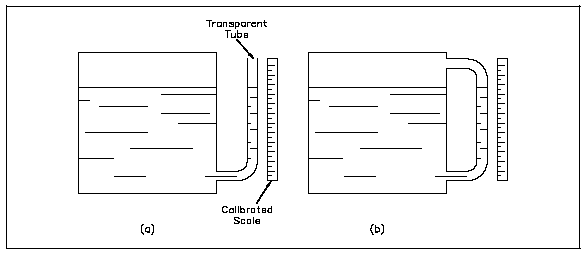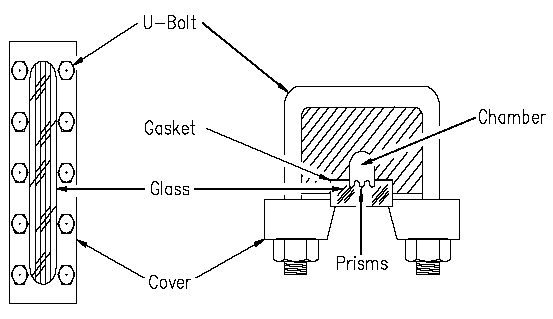Glass Gauge Type Level Detectors Review
Electronics, Instrumentation & Electrical Database
Glass Gauge Type Level Detectors Review
Glass Gauge Type Level Detectors are a very simple means by which liquid level is measured in a vessel is by the gauge glass method (Figure A1). In the gauge glass method, a transparent tube is attached to the bottom and top (top connection not needed in a tank open to atmosphere) of the tank that is monitored. The height of the liquid in the tube will be equal to the height of water in the tank.
Figure A1 (a) shows a gauge glass which is used for vessels where the liquid is at ambient temperature and pressure conditions. Figure A1 (b) shows a gauge glass which is used for vessels where the liquid is at an elevated pressure or a partial vacuum. Notice that the gauge glasses in Figure A1 effectively form a "U" tube manometer where the liquid seeks its own level due to the pressure of the liquid in the vessel.
Gauge glasses made from tubular glass or plastic are used for service up to 450 psig and 400F. If it is desired to measure the level of a vessel at higher temperatures and pressures, a different type of gauge glass is used. The type of gauge glass utilized in this instance has a body made of metal with a heavy glass or quartz section for visual observation of the liquid level. The glass section is usually flat to provide strength and safety. Figure A2 illustrates a typical transparent gauge glass.
Another type of gauge glass is the reflex gauge glass (Figure A3). In this type, one side of the glass section is prism-shaped. The glass is molded such that one side has 90-degree angles which run lengthwise. Light rays strike the outer surface of the glass at a 90-degree angle. The light rays travel through the glass striking the inner side of the glass at a 45-degree angle. The presence or absence of liquid in the chamber determines if the light rays are refracted into the chamber or reflected back to the outer surface of the glass.
When the liquid is at an intermediate level in the gauge glass, the light rays encounter an air-glass interface in one portion of the chamber and a water-glass interface in the other portion of the chamber. Where an air-glass interface exists, the light rays are reflected back to the outer surface of the glass since the critical angle for light to pass from air to glass is 42 degrees. This causes the gauge glass to appear silvery-white. In the portion of the chamber with the water-glass interface, the light is refracted into the chamber by the prisms. Reflection of the light back to the outer surface of the gauge glass does not occur because the critical angle for light to pass from glass to water is 62-degrees. This results in the glass appearing black, since it is possible to see through the water to the walls of the chamber which are painted black.
A third type of gauge glass is the refraction type (Figure A4). This type is especially useful in areas of reduced lighting; lights are usually attached to the gauge glass. Operation is based on the principle that the bending of light, or refraction, will be different as light passes through various media. Light is bent, or refracted, to a greater extent in water than in steam. For the portion of the chamber that contains steam, the light rays travel relatively straight, and the red lens is illuminated. For the portion of the chamber that contains water, the light rays are bent, causing the green lens to be illuminated. The portion of the gauge containing water appears green; the portion of the gauge from that level upward appears red.

Figure A4


